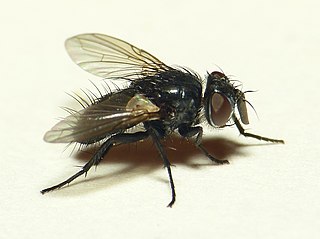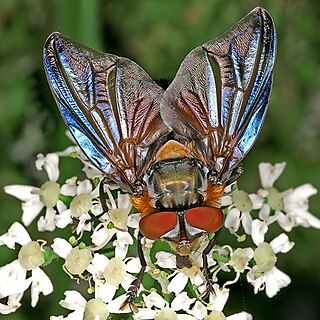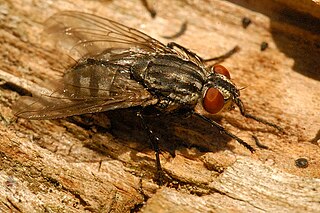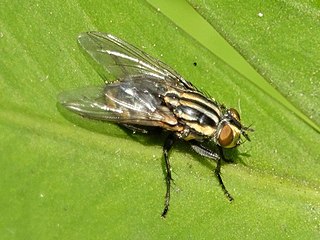| Sarcophaga | |
|---|---|
 | |
| Sarcophaga africa | |
| Scientific classification | |
| Domain: | Eukaryota |
| Kingdom: | Animalia |
| Phylum: | Arthropoda |
| Class: | Insecta |
| Order: | Diptera |
| Family: | Sarcophagidae |
| Subfamily: | Sarcophaginae |
| Genus: | Sarcophaga Meigen, 1826 [1] |
| Type species | |
| Sarcophaga carnaria | |
Sarcophaga is a genus of true flies and the type genus of the flesh-fly family (Sarcophagidae). The members of this cosmopolitan genus are frequently known as common flesh flies. There are more than 1000 species in Sarcophaga. [3]
Contents
This genus occurs essentially worldwide. These flies are generally well-sized and of a greyish color; like many of their relatives, the typical patterns are lengthwise darker stripes on the thorax and dark and light square dots on the abdomen. Many have conspicuous red compound eyes. These are set further apart in females than in males; the females are also larger on average. As typical for this family, it is almost impossible to tell the species apart from their outward appearance, and many can only be reliably identified by microscopic examination of the males' genitalia. [4]
As the common name implies, their larvae typically feed on decaying meat. Some, however, instead eat the bacteria and other small organisms living on carrion. Many species have adapted to humans, and while they are usually nuisance pests, some are medically significant vectors of pathogens and bacteria. Sometimes, the larvae cause myiasis. Others are parasitoids of pest caterpillars and beneficial in forestry and orchards.
Well-known species are Sarcophaga africa , Sarcophaga bercaea, the grey flesh-fly Sarcophaga bullata , Sarcophaga carnaria , Sarcophaga crassipalpis , the friendly fly Sarcophaga aldrichi and the red-tailed flesh-fly Sarcophaga haemorrhoidalis .







